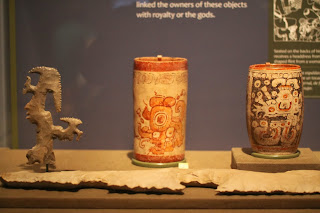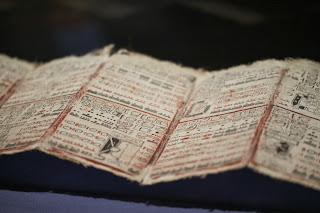I had to collect a few photographs of the title of the exhibit. My head swiveled whenever I'd hear her name: Maya! It took a while to realize my daughter wasn't along on this particular poetry date. Just me and Meryl and Opal. <3
Most of the blurbs I've written here come word-for-word from plaques in the museum or are slight adaptations. All typos are, of course, mine.
At the start of the exhibit, there are these immense totems, called stela (plural stelae). One told of how the gods brought the world into being on August 13, 3114 BC, by placing three hearthstones into the sky. That act created the universe and established cosmic order. On that date, the Maize God sprouted like a cornstalk from the back of the Earth Turtle.
The Maya saw the world as the back of a giant turtle, with the underworld below and heaven above. Periodically, the Rain God Chac split the shell so that the Maize God could sprout.
Chac, the Rain God, wielded an axe like this one. As he strode through the sky, strikes from his axe created thunder and sparked bolts of lightning.
Ways of divination.
Scribes would record in bark-paper books: Maya history and habits of stars and eclipses, which determined the timing of warfare, rituals, and agricultural tasks.
Top: Painted pot. Centuries ago, a scribe brightly painted the thin stucco covering this clay pot. In 2011 researchers found it in a royal tomb with the stylus and palette.
Middle: Stylus. When not writing, they stored these valuable tools in their headdresses.
Bottom: Paint palette. This shell was used for mixing and storing paint.
Ritual objects.
Bottom: The whiskery fish barbels on the faces of these commonly found containers suggest a connection to the underworld. The jars and the offerings inside them sanctified household shrines and facilitated communication with ancestors.
Maya commoners wore shell, clay, and mother-of-pearl: Jade and obsidian may have been reserved for the elite and fmous, but ordinary Maya had plenty of jewelry.
Women's blouses, called huipiles--
Top: spools
Middle: bone needles
Bottom: stamps
The Maize God carries the universe: The figures on this vase act out the Maya creation story. With their leafy costumes and corncob heads, they represent the Maize God--the personification of sustenance and renewal--carrying the sky, Earth and underworld on his back. He dances around the vase, preparing the universe for life.
Top: dog head incense burner. All Maya societies kept dogs, and archaeologists often find their remains in graves. The Maya believed that dogs--faithful companions even after death--guided souls on the terrifying journey through the underworld.
Second from bottom: crocodile effigy vessel. The cosmic crocodile symbolizes the world afloat above the dangerous waters of Xibalba. Here, a god emerges from the crocodile's mouth.
Bottom: Vessels painted with bat designs. With sound scrolls curling from their mouths and death symbols on their wings, these bats are fearsome. The Maya associated them with decapitation, and a Maya legend tells of giant bats that behead on of the Hero Twins.
Lightning God: will split open the earth, revealing portals to the underworld and allowing seeds to grow.
The lady offers a sacrifice: Lady K'abal Xook kneels beneath a torch held by her husband, Itzamnaaj Bahlam III of Yaxchilan. In an expression of deep piety, she pulls a thorny rope through her tongue. Drops of blood curl from her mouth, falling into a bowl of paper below. Later, she'll burn the paper and the smoke from her offering will attract the gods.
Deep in trance, this priest transforms into a jaguar--his spirit companion. Cat ears sprout from his skull, and his hands have become paws. A powerful spirit companion could strengthen and protect a priest confronting celestial forces or engaged in battle.
Bowl's offering included: stingray spines, used in bloodletting rituals to open portals into spirit worlds; seashells symbolizing the watery underworld; and jade, a symbol of rebirth. Some had been burned: the smoke carried their essence to the gods.
Pieces of shell, probably sewn onto a garment, to be taken along to the underworld.
Top: ideal beauty, which included flattened foreheads; slightly crossed eyes; pierced ears, noses and lip; teeth filed into patterns and inlaid with jade or hematite; tattooed and painted bodies; and hairstyles that suggested maize foliage. The perfect nose was a large straight one, often achieved with an artificial bridge.
2: labret (only worn by men)
Blood sacrifice:
Top is male poised for bloodletting ritual.
Middle is a carved stingray spine. The elite used these to draw blood. These were sometimes found in a "sacred toolkit" to use on the journey in the other world.
Bottom is part of a hairpin or spatula, which depicts to individuals in bloodletting ritual. The man on the right draws blood from his genitals, unleashing a writhing serpent that aids in contacting gods or ancestors.














































































No comments:
Post a Comment